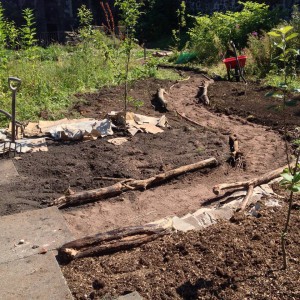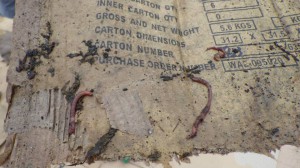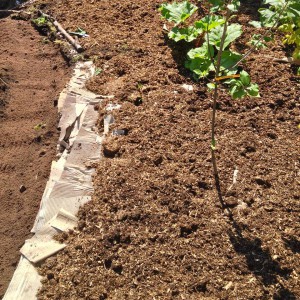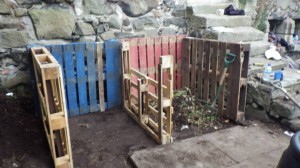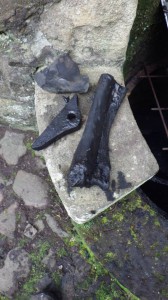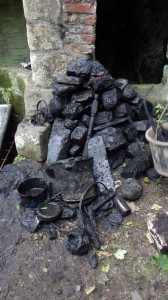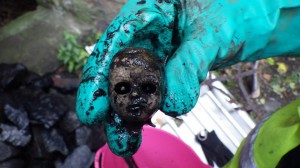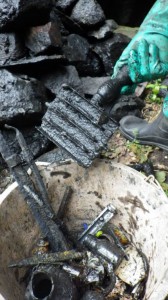
Since my last blog there has been a flurry of activity in John Cowane’s House, the site of the Transition Stirling forest garden project which I’ve been working on. Taking on the development of a community garden as my personal project has been a big task but it’s fantastic to be able to look back even after a few months and see how much we’ve achieved.
Over the last six weeks I’ve run several sessions in the garden and thanks to the efforts of lots of volunteers the rough plans for the garden are starting to come into being. One of the main issues we had was that large parts of the garden had previously been paved. This meant that we not only had to move the slabs, but also dig out large sections of sand. Luckily, our plans included creating a path through the centre of the main bed so we were able to use the sand for this – the slabs were also used for a perimeter path. As a soil survey of the garden showed us that in general we had quite acidic, sandy soil (with no worms!) we also made a start preparing our beds using a permaculture technique known as lasagna gardening or sheet mulching. This requires layering cardboard, compost or manure and mulch to suppress weeds and enrich the soil. One of the many advantages of this is that it means no digging! Cardboard can also be laid on top of weeds provided they are not too tall. We used manure which was already full of the lovely worms we need to keep soil healthy for growing.
Transition Stirling’s August skill sharing event was also garden themed as we learned all about making compost. From this, we were able to agree on how we want to make our compost, including what weeds we want to compost and what kind of bins to have. This knowledge was put into action last weekend as we built our own compost bins very simply from old pallets and stakes which had been left in the ruin.
Last weekend we also had help from Stirling Council Ranger Service to start to dig out the well inside the ruin and begin to tackle some of the weeds which are damaging the walls. Digging the well was a fascinating walk through history. From the most recent layer we filled several bags full of rubbish and crisp packets. Beneath this we began to find pots, crockery, coins, weights, pieces of basic machinery and even a doll. Luckily, we had Stirling Council archaeologist, Murray Cook volunteering on the day so we were able to identify a lot of the things which came out of the well such a massive cow’s leg bone. Here’s some pictures of our findings:
It’s really so exciting to be working to create a community space within such a beautiful and historic site, a feat which would not be possible without the support of all the other groups involved and the landowners, The Patrons of Cowane’s Hospital Trust.
Looking ahead I’m excited to begin working with Allan’s primary ecogroup running some activities in the garden, to finish the preparation of the ground, begin planting some more trees and the shrub layer of plants.

